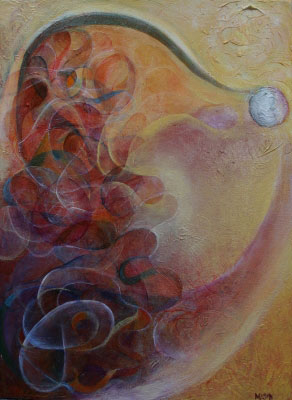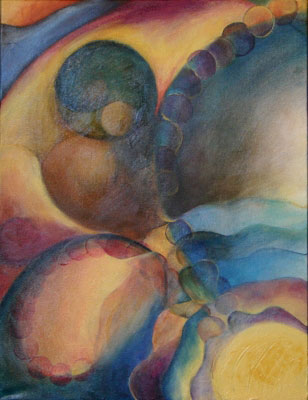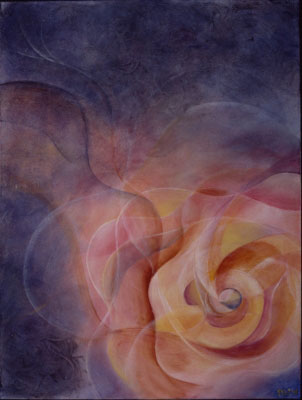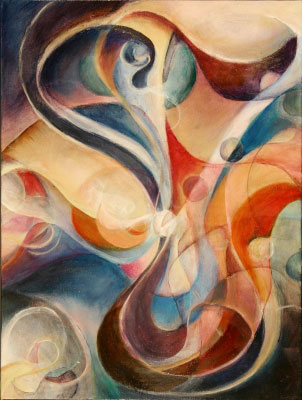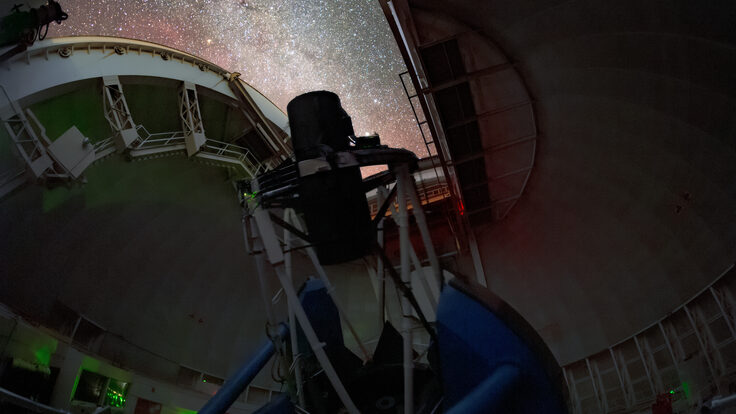Gallery: Dawn Meson
by Raven Hanna
From cave paintings of bison to Monet landscapes, artists have studied and interpreted the natural world. Dawn Neal Meson, a San Francisco artist, has taken this theme one level further, or, rather, many orders of magnitude smaller.
The subjects of Sum Over Histories, Meson's latest series of acrylic paintings, feature aspects of nature at the particle physics level: colliding electrons, multidimensional surfaces, entangled particles, and string theory. Her goal is to illuminate invisible worlds, unseen and unseeable. Through these works she answers her own question, what can art contribute beyond photography?
All paintings: Dawn Neal Meson, Left: Collision III, Right: Decay III |
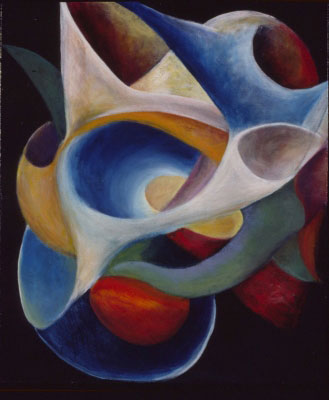 Kaluza-Klein (Invisible Architecture III) |
| "Scientists and artists are the official noticers of society." Frank Oppenheimer |
Meson's paintings document her personal process of understanding the concepts and theories of modern physics. Her paintings are not intended as scientific illustrations that instruct, but she hopes they might inspire.
| "Dawn Meson has good intuition-she asks good questions... There is both an artistic and scientific process in both art and science." Stephon Alexander |
Trained as a fine artist, Meson remembers having interest in her college physics class; but it took her 10 years to reunite with the subject. She began by reading popular modern physics books, from the likes of Richard Feynman, David Lindley, and Brian Greene, digesting the concepts through equations and sketches in her notebook. She then sought help. "Nothing like having a brilliant theoretical physicist to answer questions," she says.
|
Stephon Alexander, a physicist at Stanford Linear Accelerator Center, met with Meson to help her work through the mathematics behind the more perplexing physics. "She has good intuition—she asks good questions," he says. Alexander is enthusiastic about the mix of science and art in Meson's work. "There is both an artistic and scientific process in both art and science."
|
To express complex theoretical concepts, Meson invented systems of symbols and shorthand. When painting actions, such as particles colliding, she chose to use a billiard ball representation and show stages of the interaction superimposed. When the subjects were the particles themselves, she chose to represent their wave nature, reminiscent of flowers, with the petals symbolizing probability waves, color-coded so that the more saturated hues correspond to the highest probabilities.
What does it mean to see a subatomic entity? Color and shape have no meaning for the very small. Yet, many physicists think in images. Alexander says he "approaches research from an intuitive, visual space."
| "Spin has nothing to do with visual reality." Dawn Meson |
A difference between most art inspired by nature, and Meson's paintings: most viewers will have less familiarity with her subject matter. In gallery shows, Meson's paintings are accompanied by paragraphs explaining their scientific basis. She notes that her work can be appreciated on multiple levels, for the esthetics and the science. For non-scientists, Meson would like her work to interest them in science. For scientists, she hopes her work will be inspirational.
The rest of this gallery and Dawn Neal Meson's other work can be viewed at www.dawnmeson.com
Click here to download the pdf version of this article.



